Data centers are choosing Indiana. Is the state’s electricity supply ready?
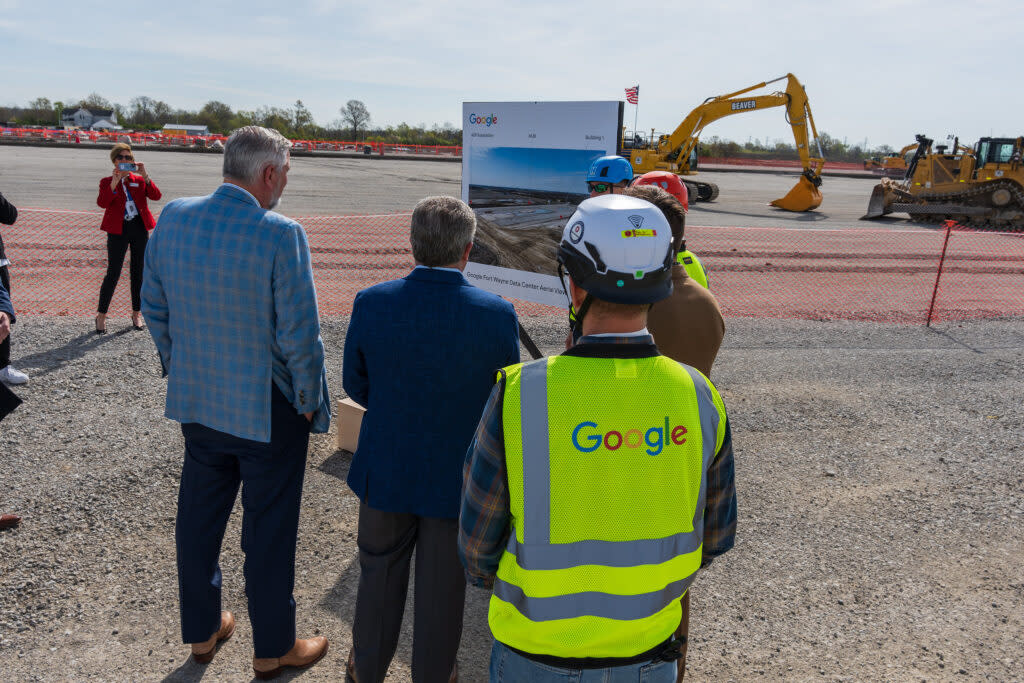
- Oops!Something went wrong.Please try again later.
Indiana Gov. Eric Holcomb, in blue, looks at an aerial overview of Google's data center project in Fort Wayne during an announcement and groundbreaking ceremony on April 26, 2024. (From Holcomb's official Flickr)
They’re cryptocurrency miners and social media businesses. They’re software providers and cloud computing companies.
And they’re increasingly setting up shop in Indiana, via data centers: windowless stretches of buildings that house computing equipment, network infrastructure and digital storage.
In the five years since lawmakers approved generous financial incentives specific to data centers, eight have located to Indiana. Four announcements have come in the last six months alone.
But the advent of the Hoosier data center has fueled debate between those who fear the state may struggle to meet rising demand and those who say there’s plenty to go around.
Utilities, meanwhile, say they’ll serve their new industrial customers — including with creative deals — while protecting current customers from price hikes and outages.
Announcements pile up
The companies behind Indiana’s nascent data center boom cumulatively plan to invest at least $14 billion into their facilities.
Amazon Web Services’ $11 billion project is the bulk of the total, followed by a $2 billion Google project and $1 billion initiative from Microsoft.
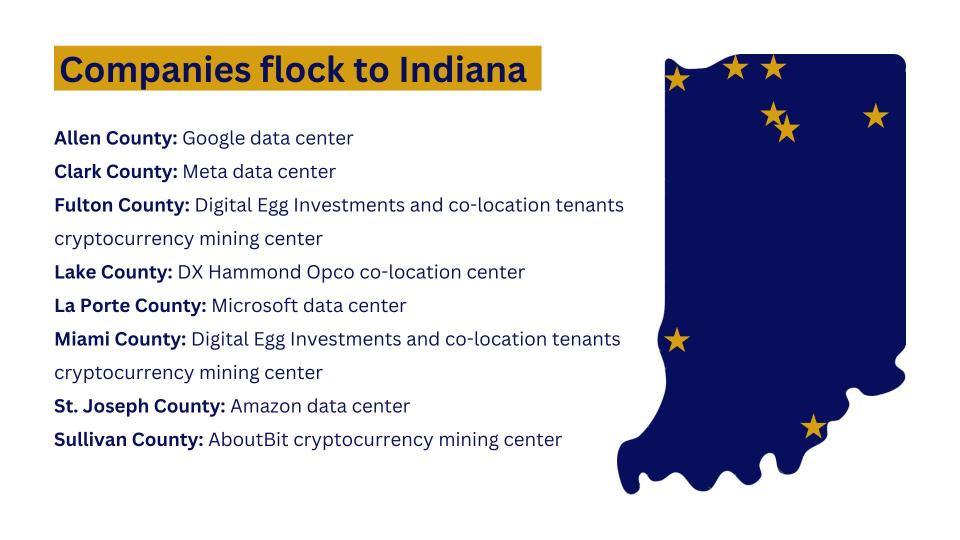
Meta, the parent company to Facebook and Instagram, is set to invest at least $800,000 into a sprawling facility, but could spend upwards of $3 billion, according to its incentive contract with the state.
Each of the companies — minus a cryptocurrency mining operation from AboutBit — is set to receive decades of benefits from the state in exchange for their investments.
Lawmakers in 2019 approved a sales and use tax exemption aimed at luring in data centers, wiping out those taxes on purchases of qualifying data center equipment and energy. Projects worth less than $750 million qualify for 25 years of the exemption, while pricier initiatives can qualify for up to 50 years.
“Like other states … Indiana created some incentives to bring these types of businesses to the state, and we’re seeing the fruit of those efforts,” said David Ober, the Indiana Chamber of Commerce’s senior vice president of business operations and finance.
“These types of projects center us in this information economy,” Ober continued. “And it’s a bit of a validation on how … we’re situated from a regulatory standpoint that these businesses want to invest significant capital here. So, from our perspective, it signifies that Indiana is a place where you want to do business.”
‘New capacity — period’
Indiana is no stranger to industry, but data centers differ.
They run all day, every day. Each facility requires massive amounts of electricity for power and water to cool itself.
“A single, 100-megawatt data center site can require as much energy as all of the homes in Fort Wayne,” I&M spokesperson Scott Blake said in a statement. “Requests for 300 to 1,000 megawatts are becoming common. These facilities also require this energy around the clock.”
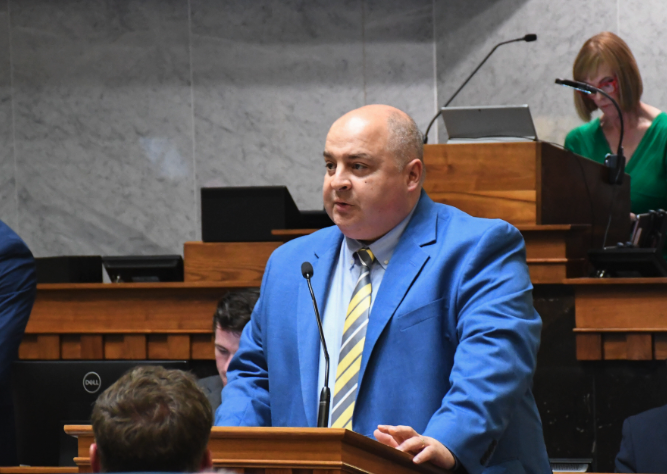
Data centers are about 3% of the country’s total power demand now. That’s expected to rise to 8% in just six years, according to an April 2024 analysis by Goldman Sachs.
Some observers fear the power-guzzlers could strain the state’s energy supply.
“We are supportive of all forms of economic development. And certainly, we want the state of Indiana to be a leader. But we are concerned about where the power for this data center revolution comes from,” said Jon Ford, a former lawmaker now leading fossil fuels interest group Reliable Energy, Inc.
“Right now, let’s pump the brakes. Let’s not shut down any fossil fuel generators,” he said. “And then let’s make a move to put new generation online. That’s renewables. That would include gas. But there’s no doubt we’re at a point in Indiana where we can’t be taking things offline. We need to add new capacity — period.”
Kerwin Olson, who leads ratepayer advocacy group Citizens Action Coalition, acknowledged the data center spurt as a “challenge,” but cautioned against hyperbole.

“This is classic exploitation of concerns around blackouts and brownouts if we don’t build new power plants and keep these coal plants open,” Olson said.
He pushed for alternatives — energy efficiencies, energy storage, micro-grids, and more — to avoid “spending billions and billions, if not trillions, of public money.”
Ober, who previously served on the powerful Indiana Utility Regulatory Commission (IURC), said he takes a “middle” view.
He described utilities’ demand projections for the last decade as “pretty flat” — and noted electrification is pushing demand higher.
“We have not accommodated for that level of demand growth in utility planning over the past 10 years,” Ober continued. “… It complicates an equation. But utility companies and these types of businesses, they look, they take a long view, and I’m confident that there’s really smart people who are able to determine how much power is needed and how to make sure that we’ve got enough for all the users on the system.”
‘Ample’ supply
Others are bullish on Indiana’s electricity capabilities.
Indiana Gov. Eric Holcomb told reporters last month that Amazon, for example, “wouldn’t have made the commitment without the confidence that we can supply both the power and the water.”
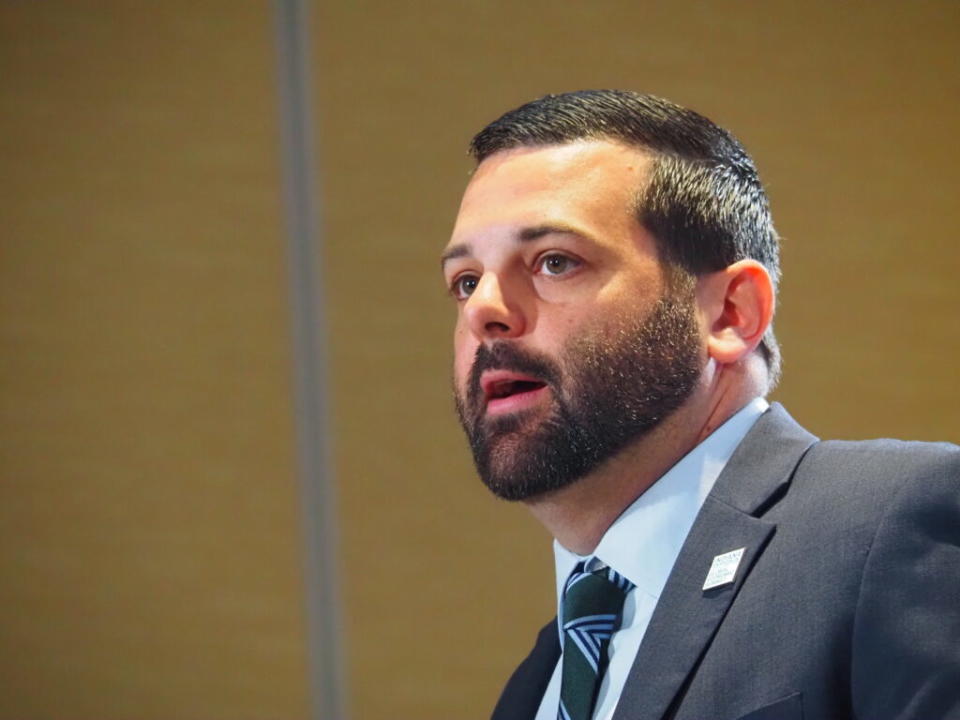
Commerce Secretary David Rosenberg, head of the Indiana Economic Development Corp. (IEDC), said the state has “ample amounts of both” power and water, adding, “Indiana’s very blessed.”
The IEDC has never declined an economic development opportunity over energy supply, according to spokeswoman Erin Sweitzer.
Rosenberg also told reporters his agency has been “very strategic” in pointing companies to locations with plenty.
Utilities have also guided interested businesses.
For instance, it was utility Indiana Michigan Power (I&M) that brought the Google project to Fort Wayne, John Urbahns told the Capital Chronicle. He is president and CEO of the area’s chamber of commerce, Greater Fort Wayne Inc.
“The specific area that was chosen was really the confluence of electric capacity and water capacity,” Urbahns said.
“I feel confident in their planning, where they’re heading and how they’re working to ramp up to serve different projects, and that we’ve got the capacity to serve additional projects,” he said of the area’s utilities. “… Our conversations with them have been making sure that we have the capacity to continue to grow.”
Forecasting for the future
Utilities say they’ve got it under control.
“Our energy companies have an obligation to serve, and we are investing in the energy future to meet those demands today and tomorrow,” Indiana Energy Association President Danielle McGrath said. The trade association represents the state’s investor-owned electric utilities and several natural gas utilities.

McGrath said utilities are preparing via integrated resource plans (IRPs). They forecast demand and how they’ll meet it with service that’s safe, reliable and priced at “just and reasonable” rates.
Utilities must hold public meetings while formulating the plans, and must submit them to the state’s regulators every three years.
Three of the state’s big five investor-owned electric utilities are in the midst of the planning process.
“We’re planning now for tomorrow’s energy needs, including the future potential load growth scenarios and needs associated with large-scale projects such as data centers,” Northern Indiana Public Service Company (NIPSCO) spokesman Rick Calinski said in a statement.
Accordingly, data centers are named multiple times — as drivers of load uncertainty that NIPSCO will model individually — in the utility’s IRP public meeting slides.
Calinski said NIPSCO would avoid harming people already in its service territory.
“We will not compromise the reliability of the service we provide, and a key priority is to ensure that existing customers are appropriately protected (in terms of both reliability and cost) with the addition of any new customer growth,” he said.
He said the facilities could even benefit other customers.
“Data centers help diversify NIPSCO’s large customer makeup and reduce exposure to potential volatility from unforeseen changes in the steel and manufacturing industry – which can have an adverse effect on customers as a result,” Calinski said. “Additionally, all customers benefit from the shared services costs that can be spread across an expanded customer base.”
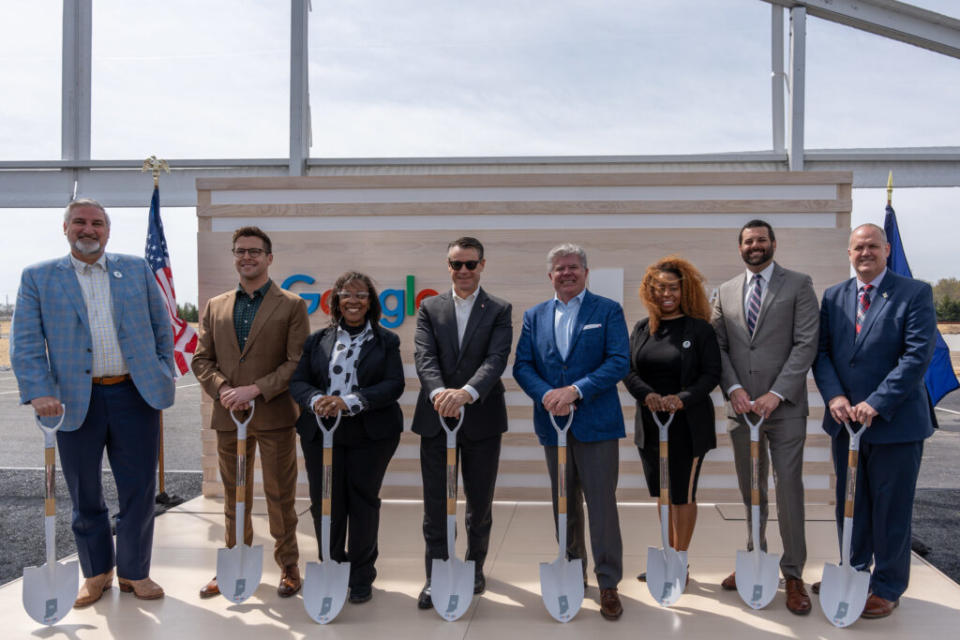
I&M spokesman Blake said the utility’s teams are “working with these large customers and regulators as we plan to power the next century of the Indiana economy. Our process will continue to focus on developing long-term plans that protect residential customers, while allowing our economy to thrive.”
“We have the resources to support our current customers, commercial and light industrial expansion, and new residents,” Blake said. “I&M will continue to be a partner in bringing job-creating industries, like EV battery manufacturers, to our service territory.”
I&M disclosed in filings with the IURC that it expects “more than a gigawatt increase” in its capacity requirements by regional transmission organization PJM’s 2027/2028 planning year. The projects cited included the Amazon and Google data centers, along with an electric vehicle battery plant.
Duke Energy Indiana spokeswoman Angeline Protogere noted the utility’s IRP is due in November.
In public meeting slides, Duke projected industrial sales would continue to rise, noting, “Economic Development efforts have attracted large industrial projects over the near term, beyond what is support by (the) existing composition of customers.”
Duke’s economic development pipeline is expected to grow to between 400 and 500 megawatts by 2030, according to the slides, with 70% of the pipeline related to batteries and the remaining 30% for other manufacturing.
One thing won’t be in Duke’s IRP, however.
Going green — kind of
Meta wants its Clark County data center to run “100%” on renewable energy, according to a news release.
Through a new LLC called Blocke, the company inked a deal with Duke involving renewable purchase power agreements. The expected load and rates were redacted as confidential.
But when those don’t deliver enough energy, the deal allows Duke to buy electricity straight off the region’s market on Blocke’s behalf.
Duke confirmed the deal in an emailed statement.
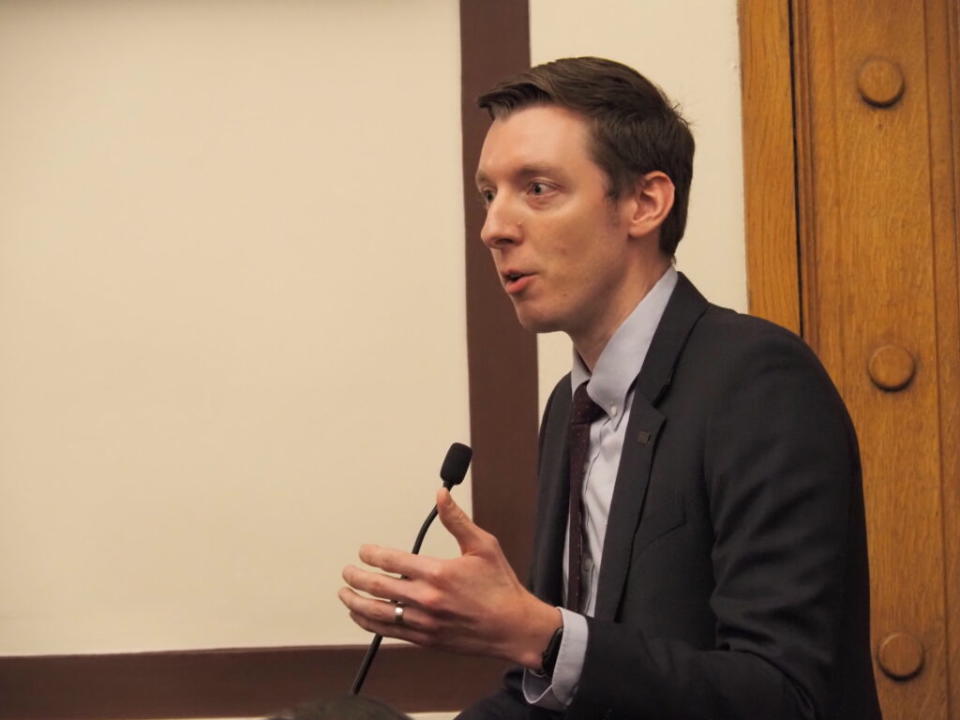
It’s been done before, per Ober.
“It’s not unprecedented to allow large energy consumers to have some exposure to bulk power markets,” he said. “To me, it sounds like … they’re offsetting a portion, or all of their demand by doing it this way, and that would protect Duke’s ratepayers who otherwise may be exposed to increased costs. And I think that generally is a smart way to address the problem of: how do you accommodate a big user on the system that may not have that much slack?”
Duke spokeswoman Protogere defended the deal, writing that regulators reviewed the contract to verify that “the customer is covering the utility’s cost of providing service to them … .”
The Office of Utility Consumer Counselor, a state agency representing ratepayers, agreed in regulatory filings that the contract “does not create additional costs for other customers,” and said the agreement “ensures Blocke bears all responsibility for costs it causes and makes some contribution to fixed costs.”
Not everyone’s happy with the deal, however.
Citizen Action Coalition Policy Director Ben Inskeep noted that Duke received approval to shift $82 million of transmission upgrades — required to connect the data center to the grid — onto other ratepayers.
In regulatory filings, Duke moved to keep the deal out of its IRP because it plans to serve Blocke via “dedicated” renewable energy facilities and will keep the company’s market-rate purchases separate from its other customers.
Regulators agreed, writing in a final order: “… due to the individualized nature of the Agreement with Customer, we approve Petitioner’s request to exclude the Agreement from its overall IRP planning process.”
A ‘living wage’
Local economic development officials say they just want to provide for their communities.
The River Ridge Development Authority, located in Clark County, is charged with replacing the economic activity lost — 27,000 jobs across 13,000 acres of land — when the U.S. Army ceased operations there about 25 years ago.
About half that land is now a state park. River Ridge has about 12,000 jobs on what remains.
For Wendy Dant Chesser, River Ridge’s chief director for corporate strategy and external affairs, the Meta data center is a chance to progress on those employment goals.
She said the company has committed to creating just 100 jobs, but with each earning about $100,000 annually on average.
“That’s good for our economy. We are trying to bring in jobs that pay above the living wage,” Dant Chesser said.
Need to get in touch?
Have a news tip?
A living wage in Clark County is about $40 hourly for a family of four with one breadwinner, according to the Massachusetts Institute of Technology’s calculator. That’s about $80,000 a year.
“We’re bringing in the types of jobs that people can sustain themselves and their families,” Dant Chesser said.
And, since learning of Google’s project, 18 other companies have inquired about joining the company at River Ridge, according to Dant Chesser.
She also noted the development will support other companies.
“There are a lot of contractors that will be badging in and out of that center every day,” Dant Chesser said. “… They could be (working for) companies that are here locally, … or they could be visitors to our area that are here on business who are going to be staying at our hotels (and) meeting at our restaurants.”
Urbahns, of Greater Fort Wayne Inc., said his organization has also focused on growing high-wage jobs, and specifically in the city’s southeast area.
“It’s been an area that has seen less investment … and this brought both of those to that part of the community,” Urbahns said of the Google deal.
Urbahns said his organization hadn’t actively sought a data center — calling the project “new for us” — but described it as a way to diversify the region’s economy.
“We’ve got the insurance industry, we’ve got manufacturing, we’ve got the defense industry, logistics. We didn’t have a data center, ” he said. “… You know, I don’t see us having becoming a hotbed for them, but it was an opportunity to have one, and have a significant one, that really continues to put us on the map of growth throughout the state and throughout the nation.”
GET THE MORNING HEADLINES DELIVERED TO YOUR INBOX
The post Data centers are choosing Indiana. Is the state’s electricity supply ready? appeared first on Indiana Capital Chronicle.

